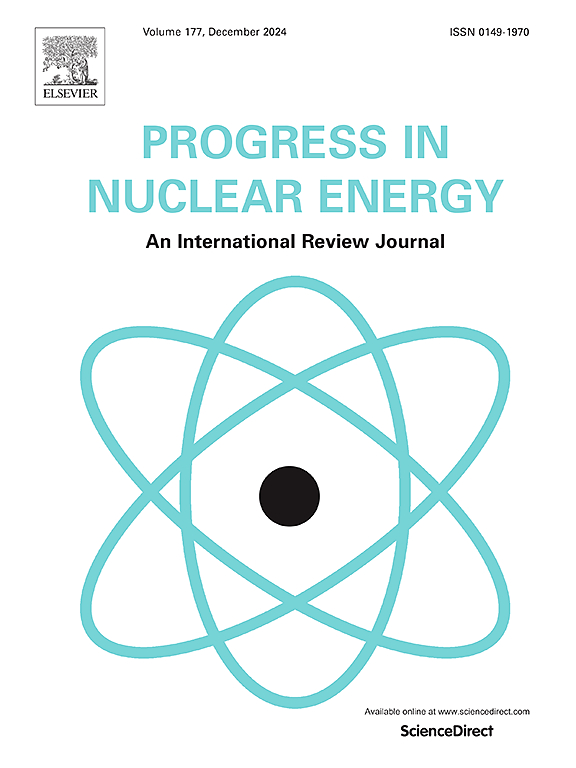Statistical evaluation comparing strength of new and aged nuclear grade HEPA filters
IF 3.3
3区 工程技术
Q1 NUCLEAR SCIENCE & TECHNOLOGY
引用次数: 0
Abstract
Nuclear grade high-efficiency particulate air (HEPA) filter service life is generally limited to 10 years from the date of manufacture at Department of Energy facilities. Filter life extension offers a substantial cost savings and decreased facility downtime. This study compared tensile strength results between unused new and unused aged filters (7, 10, and 13 years old) to discern age related differences. Unused HEPA filters were disassembled. The filter sheets were preconditioned in a controlled environment for 24 h to resolve any atmospheric history of the filter media and to remove any effects of hysteresis on the results. Media used in HEPA filters are fragile, and damage occurs outside of the sample area when the material is cut. Basis weight measurements were recorded. Machine direction (MD) and cross direction (CD) tensile strength specimens were taken from the top or bottom of each filter pleat. Tensile strength specimens were also obtained of the pleat fold in the machine direction. Burst strength specimens were taken from across each filter pleat from top to bottom. Analysis of the raw data suggests that differences in tensile strength between new and aged HEPA filters are not significant. These results complement previous studies that have evaluated the relationships between the postulated 10-year HEPA filter lifespan, other performance indicators, and assessed cohort of aged filters as a function of normal operations. Those results along with the tensile strength results reported here suggest that HEPA filters, when properly maintained, can reasonably operate safely and efficiently for extended periods beyond 10 years when managed with well-defined performance and operational requirements.
新旧核级HEPA过滤器强度对比统计评价
核级高效微粒空气过滤器(HEPA)的使用寿命一般限制在10年,从制造之日起,在能源部设施。过滤器寿命的延长大大节省了成本,减少了设备停机时间。本研究比较了未使用的新过滤器和未使用的旧过滤器(7、10和13年)的抗拉强度结果,以辨别年龄相关的差异。拆卸未使用的HEPA过滤器。过滤片在受控环境中预处理24小时,以解决过滤介质的任何大气历史,并消除任何迟滞对结果的影响。HEPA过滤器中使用的介质是易碎的,当材料被切割时,样品区域外会发生损坏。记录基础体重测量值。机器方向(MD)和交叉方向(CD)拉伸强度标本取自每个滤褶的顶部或底部。在机器方向上也获得了褶皱的抗拉强度试样。从上到下采集每个滤褶的破裂强度样本。原始数据分析表明,新旧HEPA过滤器的抗拉强度差异不显著。这些结果补充了先前的研究,这些研究评估了假设的10年HEPA过滤器寿命,其他性能指标以及评估的老化过滤器作为正常操作的功能之间的关系。这些结果以及本文报告的抗拉强度结果表明,在良好的性能和操作要求管理下,如果维护得当,HEPA过滤器可以合理地安全高效地运行超过10年。
本文章由计算机程序翻译,如有差异,请以英文原文为准。
求助全文
约1分钟内获得全文
求助全文
来源期刊

Progress in Nuclear Energy
工程技术-核科学技术
CiteScore
5.30
自引率
14.80%
发文量
331
审稿时长
3.5 months
期刊介绍:
Progress in Nuclear Energy is an international review journal covering all aspects of nuclear science and engineering. In keeping with the maturity of nuclear power, articles on safety, siting and environmental problems are encouraged, as are those associated with economics and fuel management. However, basic physics and engineering will remain an important aspect of the editorial policy. Articles published are either of a review nature or present new material in more depth. They are aimed at researchers and technically-oriented managers working in the nuclear energy field.
Please note the following:
1) PNE seeks high quality research papers which are medium to long in length. Short research papers should be submitted to the journal Annals in Nuclear Energy.
2) PNE reserves the right to reject papers which are based solely on routine application of computer codes used to produce reactor designs or explain existing reactor phenomena. Such papers, although worthy, are best left as laboratory reports whereas Progress in Nuclear Energy seeks papers of originality, which are archival in nature, in the fields of mathematical and experimental nuclear technology, including fission, fusion (blanket physics, radiation damage), safety, materials aspects, economics, etc.
3) Review papers, which may occasionally be invited, are particularly sought by the journal in these fields.
 求助内容:
求助内容: 应助结果提醒方式:
应助结果提醒方式:


